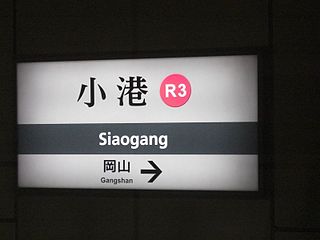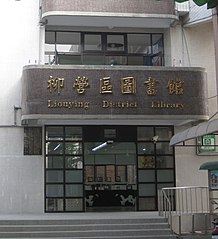Tongyong Pinyin
Tongyong Pinyin ( Chinese 通用 拼音 , Pinyin Tōngyòng Pīnyīn , Tongyong Pinyin Tongyòng Pinyin - "Commonly used phonetic transcription ") is a transcription (or Romanization ) of the Chinese language developed in the Republic of China on Taiwan . Like the Hanyu Pinyin developed in the People's Republic of China , it is based on the pronunciation of the Peking dialect . About 80 percent of the syllables of Tongyong Pinyin are identical to the corresponding syllables in the spelling of Hanyu Pinyin.
Between 2002 and 2008, Tongyong Pinyin served as the official Romanization of Chinese in Taiwan in the Republic of China . In this role, it was replaced by Hanyu Pinyin on January 1, 2009 by resolution of the Kuomintang government elected one year earlier . However , Tongyong Pinyin is still in use in some cities and counties ruled by the opposition DPP party .
history
Tongyong Pinyin is a version of the phonetic transcription Mandarin Phonetic Symbols II , which was further developed by Yu Bor-chuan ( 余伯泉 , Yú Bóquán ) in 1998 , but some further modifications have been made since then.
Differences from Hanyu Pinyin
Sound-letter assignment
In the spelling of the syllables, Tongyong Pinyin differs from Hanyu Pinyin as follows:
- The sound reproduced in Hanyu Pinyin with zh is written jh . Example: zhong - jhong
- The letters s and c have two uses in Tongyong Pinyin: Before a, e, o, u and ih they have the same meaning as in Hanyu Pinyin; before the vowels i and yu they correspond to the sounds x and q in Hanyu Pinyin. The letters x and q do not appear in Tongyong Pinyin. Examples: san - san, ci - cih, xing - sing, qi - ci
- That in Hanyu Pinyin in the syllables zi (資), ci (慈), si (思), zhi (知), chi (吃), shi (詩), and ri (日) as i ( not separately in Zhuyin sound is indicated in Tongyong Pinyin (as in part also in Wade-Giles ), by the ending ih . Examples: shi - shih, zhi - jhih
- The ü used in Hanyu Pinyin is replaced by yu , even in those cases in which in Hanyu Pinyin the dots above the u are omitted. Examples: nü - nyu, qu - cyu, xue - syue
- eng (as in 蹦 、 碰 、 孟 、 奉 、 瓮) is written after b-, p-, m-, f-, w- ong . Example: feng - fong
- wen (溫) becomes to wun .
- iong is always written as yong . Example: xiong - syong
- The triple vowels ( triphthongs ) iou and uei - z, contracted to iu and ui in Wade-Giles and Hanyu Pinyin . B. in liu (六) and gui (鬼) - may optionally also be written out. (The names of smaller communities must always be written out in full in the transcription.)
Of the 416 standard Chinese syllables, 335 are spelled the same in Hanyu Pinyin and Tongyong Pinyin. Only in two cases ( ci and si ) does the transcription denote different syllables depending on the system.
Other differences
- Tongyong uses the characters for to differentiate sound movements like the zhuyin , and not like the hanyu pinyin, i.e. H. the first tone is not marked, whereas the light (“neutral” tone) can be marked with a dot.
- As in Hanyu Pinyin, syllables can be separated by an apostrophe to avoid possible confusion , e.g. B. ji'nan or jin'an . Sometimes, as with place names, a hyphen is also used .
- Although the capitalization of the first letter of every syllable was not originally intended, this is practiced in different places (e.g. on street signs).
Tongyong Pinyin also developed a version for Taiwanese (台 語音 標 版) in which the letter f is omitted, but an additional letter v (for 万) has been added.
Controversy and spread
One point of criticism of Tongyong Pinyin is the reproduction of several initial sounds (which are differentiated in Zhuyin ) by the letters c and s . Another point is that when using Hanyu Pinyin, any Chinese syllable can be entered on the computer keyboard with the same number of or even fewer keystrokes. Certainly the biggest obstacle to greater acceptance of Tongyong Pinyin is that Hanyu Pinyin has already been established as a standard in the People's Republic of China and as an internationally recognized ISO standard for the transcription of high-level Chinese . Hanyu Pinyin is also an essential resource for the majority of those studying Chinese or doing business in China. Proponents of Tongyong Pinyin argue that their system dispenses with letters like q and x , which non-native speakers do not provide any indication of the pronunciation of the sounds represented in this way.
In Taiwan, the Tongyong Pinyin concept, proposed as the national standard in October 2000, met with partial rejection and sparked a political controversy, which was largely related to the different ideas of the local political groups with regard to national identity.
Tongyong Pinyin was officially introduced in August 2002, but the relevant ordinance was not binding on local administrations. Some cities run by the Kuomintang - especially Taipei - decided to use Hanyu Pinyin instead on local signage. After the change of government in 2008, the new Kuomintang government decided to introduce Hanyu Pinyin as the standard nationwide on January 1, 2009. Some cities and districts governed by the opposition party DPP, such as the sub-government cities of Kaohsiung and Tainan , are boycotting the non-binding local governments Regulation and continue to use Tongyong Pinyin in their area. This makes the nationwide use of the various transcription systems very confusing, as the same Chinese names are spelled differently depending on where you are and which authority has attached the signage.
Photos
See also
Web links
- Linguistic analysis
- Hanyu-Tongyong Comparison Chart
- Formal documents (in Chinese ): from Academia Sinica
- Toponomastic rules (in Chinese ) on Wikisource




